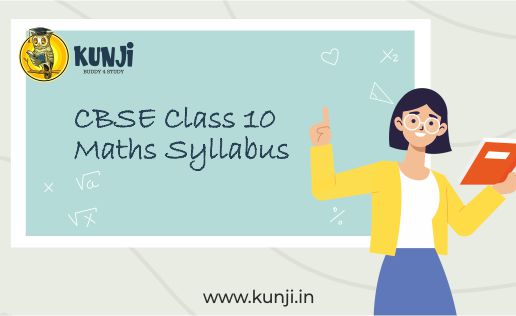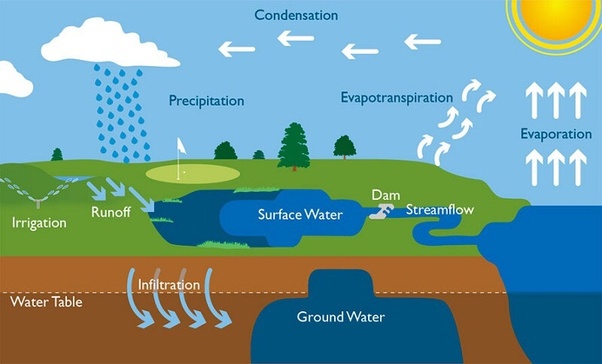Syllabus for CBSE Class 10 Maths 2020-2021 Session
This year also the CBSE Board Exam 2021 will offer two versions of Mathematics paper to students, one easy and another one of the standard level. However, the CBSE Class 10 Maths syllabus for both types of papers remains common. So, all students are advised to refer to the latest syllabus while they are preparing for their school and board examinations.
Also See: CBSE Class 10 NCERT Solutions
Contents of CBSE Class 10 Maths syllabus 2020-2021 are:
- Unit-wise weightage
- Topics and subtopics to be prepared from each unit
- Question paper design for the annual board examination
- Components of Internal Assessment
- Prescribed books
CBSE had introduced certain changes in the Maths question paper structure in the board exam 2020. About 25% of the questions in the paper were of objective type with each carrying 1 mark. The same is expected to be followed in the next year’s board examinations. For this, you can check the question paper design suggested by CBSE in this new syllabus.
Below is the complete CBSE Class 10 Maths Syllabus 2020-2021:
CBSE Class 10 Mathematics Unit-Wise Weightage
| Units | Unit Name | Marks |
| I | NUMBER SYSTEMS | 06 |
| II | ALGEBRA | 20 |
| III | COORDINATE GEOMETRY | 06 |
| IV | GEOMETRY | 15 |
| V | TRIGONOMETRY | 12 |
| VI | MENSURATION | 10 |
| VII | STATISTICS & PROBABILITY | 11 |
| Total | 80 |
Following is the CBSE Class 10 Mathematics Course Structure:
UNIT I: NUMBER SYSTEMS
- Real Numbers (15 Periods)
- Euclid’s division lemma, Fundamental Theorem of Arithmetic – statements after reviewing work done earlier and after illustrating and motivating through examples, Proofs of irrationality ofDecimal representation of rational numbers in terms of terminating/non-terminating recurring decimals.
UNIT II: ALGEBRA
- Polynomials (7 Periods)
- Zeros of a polynomial. Relationship between zeros and coefficients of quadratic polynomials. Statement and simple problems on division algorithms for polynomials with real coefficients.
- Pair of Linear Equations in Two Variables (15 Periods)
- Pair of linear equations in two variables and graphical method of their solution, consistency/inconsistency.
- Algebraic conditions for a number of solutions. The solution of a pair of linear equations in two variables algebraically – by substitution, by elimination and by cross multiplication method. Simple situational problems. Simple problems on equations reducible to linear equations.
- Quadratic Equations (15 Periods)
- Standard form of a quadratic equation ax2 + bx + c = 0, (a ≠ 0). Solutions of quadratic equations (only real roots) by factorization, and by using the quadratic formula. Relationship between discriminant and nature of roots.
- Situational problems based on quadratic equations related to day to day activities to be incorporated.
- Arithmetic Progressions (8 Periods)
- The motivation for studying Arithmetic Progression Derivation of the nth term and sum of the first n terms of an A.P. and their application in solving daily life problems.
UNIT III: COORDINATE GEOMETRY
- Lines (In two-dimensions) (14 Periods)
- Review: Concepts of coordinate geometry, graphs of linear equations. Distance formula. Section formula (internal division). Area of a triangle.
UNIT IV: GEOMETRY
1. Triangles (15 Periods)
Definitions, examples, counterexamples of similar triangles.
- (Prove) If a line is drawn parallel to one side of a triangle to intersect the other two sides in distinct points, the other two sides are divided in the same ratio.
- (Motivate) If a line divides two sides of a triangle in the same ratio, the line is parallel to the third side.
- (Motivate) If in two triangles, the corresponding angles are equal, their corresponding sides are proportional and the triangles are similar.
- (Motivate) If the corresponding sides of two triangles are proportional, their corresponding angles are equal and the two triangles are similar.
- (Motivate) If one angle of a triangle is equal to one angle of another triangle and the sides including these angles are proportional, the two triangles are similar.
- (Motivate) If a perpendicular is drawn from the vertex of the right angle of a right triangle to the hypotenuse, the triangles on each side of the perpendicular are similar to the whole triangle and to each other.
- (Prove) The ratio of the areas of two similar triangles is equal to the ratio of the squares of their corresponding sides.
- (Prove) In a right triangle, the square on the hypotenuse is equal to the sum of the squares on the other two sides.
- (Prove) In a triangle, if the square on one side is equal to the sum of the squares on the other two sides, the angles opposite to the first side is a right angle.
2. Circles (8 Periods)
Tangent to a circle at, point of contact.
- (Prove) The tangent at any point of a circle is perpendicular to the radius through the point of contact.
- (Prove) The lengths of tangents drawn from an external point to a circle are equal.
3. Constructions (8 Periods)
- Division of a line segment in a given ratio (internally).
- Tangents to a circle from a point outside it.
- Construction of a triangle similar to a given triangle.
UNIT V: TRIGONOMETRY
- Introduction to Trigonometry (10 Periods)
- Trigonometric ratios of an acute angle of a right-angled triangle. Proof of their existence (well defined); motivate the ratios whichever are defined at 0o and 90o. Values (with proofs) of the trigonometric ratios of 30o, 45o and 60o. Relationships between the ratios.
- Trigonometric Identities (15 Periods)
- Proof and applications of the identity sin2A + cos2A = 1. Only simple identities to be given. Trigonometric ratios of complementary angles.
- Heights and Distances: Angle of elevation, Angle of Depression. (8 Periods)
- Simple problems on heights and distances. Problems should not involve more than two right triangles. Angles of elevation/depression should be only 30o, 45o, 60o.
UNIT VI: MENSURATION
- Areas Related to Circles (12 Periods)
- Motivate the area of a circle; area of sectors and segments of a circle. Problems based on areas and perimeter/circumference of the above-said plane figures. (In calculating the area of a segment of a circle, problems should be restricted to the central angle of 60°, 90°, and 120° only. Plane figures involving triangles, simple quadrilaterals and circle should be taken.)
- Surface Areas and Volumes (12 Periods)
- Surface areas and volumes of combinations of any two of the following: cubes, cuboids, spheres, hemispheres and right circular cylinders/cones. Frustum of a cone.
- Problems involving converting one type of metallic solid into another and other mixed problems. (Problems with combinations of not more than two different solids are taken).
UNIT VII: STATISTICS AND PROBABILITY
- Statistics (18 Periods)
- Mean, median and mode of grouped data (bimodal situation to be avoided). Cumulative frequency graph.
- Probability (10 Periods)
- The classical definition of probability. Simple problems on finding the probability of an event.
CBSE Class 10 Maths Question Paper Design
To know the typology of questions for Class 10 Maths Board Exam 2021, go through the question paper design given below as suggested by CBSE. It will be quite helpful to structure your study plan and work in a productive way.
MATHEMATICS-Standard
Code (041)
QUESTION PAPER DESIGN
CLASS – X (2020-21)
Time : 3 Hours Max. Marks: 80
| S. No | Typology of Questions | Total Marks | % weightage approx |
| 1. | Remembering: Exhibit memory of previously learned material by recalling facts, terms, basic concepts and answers.
Understanding: demonstrate understanding of facts and ideas by organizing, comparing, translating, interpreting, giving descriptions and stating main idea. |
43 | 54 |
| 2 | Applying: Solve problems to new situations by applying acquired knowledge, facts, techniques and rules in a different way. | 19 | 24 |
| 3 | Analysing: Examine and break information into parts by identifying motives or causes. Make inference and find evidence to support generalizations.
Evaluating: Present and defend opinions by making judgements about information, validity of ideas, or quality of work based on a set of criteria. Creating: Compile information together in a different way by combining elements in a new pattern or proposing alternative solutions. |
18 | 22 |
| Total | 80 | 100 |
| Internal Assessment | 20 Marks |
| Pen Paper Test and Multiple Assessment (5+5) | 10 Marks |
| Portfolio | 05 Marks |
| Lab Practical (Lab activities to be done from the prescribed books) | 05 Marks |
MATHEMATICS-Basic Code (241)
QUESTION PAPER DESIGN
CLASS – X (2020-21)
Time: 3Hours Max. Marks: 80
| S. No | Typology of Questions | Total Marks | % weightage approx |
| 1. | Remembering: Exhibit memory of previously learned material by recalling facts, terms, basic concepts and answers.
Understanding: demonstrate understanding of facts and ideas by organizing, comparing, translating, interpreting, giving descriptions and stating main ideas. |
60 | 75 |
| 2 | Applying: Solve problems to new situations by applying acquired knowledge, facts, techniques and rules in a different way. | 12 | 15 |
| 3 | Analysing: Examine and break information into parts by identifying motives or causes. Make inference and find evidence to support generalizations.
Evaluating: Present and defend opinions by making judgements about information, validity of ideas, or quality of work based on a set of criteria. Creating: Compile information together in a different way by combining elements in a new pattern or proposing alternative solutions. |
8 | 10 |
| Total | 80 | 100 |
| Internal Assessment | 20 Marks |
| Pen Paper Test and Multiple Assessment (5+5) | 10 Marks |
| Portfolio | 05 Marks |
| Lab Practical (Lab activities to be done from the prescribed books) | 05 Marks |
PRESCRIBED BOOKS:
| 1. Mathematics – Textbook for Class X – NCERT Publication |
| 2. Guidelines for Mathematics Laboratory in Schools, class X – CBSE Publication |
| 3. Laboratory Manual – Mathematics, secondary stage – NCERT Publication |
| 4. Mathematics exemplar problems for class X, NCERT publication. |
Also See:
- CBSE Class 10 Maths Syllabus for 2020-21
- CBSE Class 10 Hindi Syllabus for 2020-21
- CBSE Class 10 Home Science Syllabus for 2020-21
- CBSE Class 10 English Syllabus for 2020-2021
- CBSE Class 10 Science Syllabus for 2020-21
- CBSE Class 10 Japanese Syllabus for 2020-21
- CBSE Class 10 German Syllabus for 2020-2021
- CBSE Class 10 French Syllabus for 2020-2021





